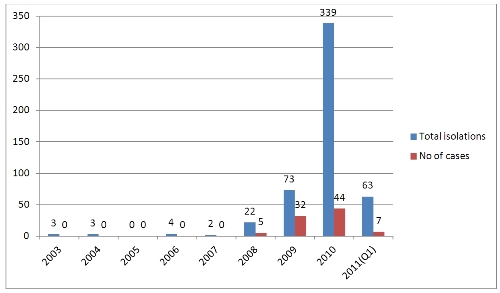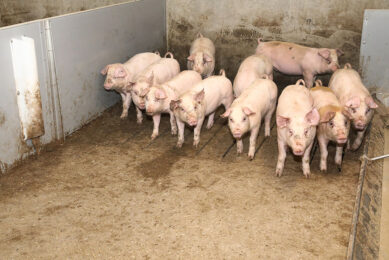Carbapenemase resistance

The medical doctors have faced a number of resistance epidemics such as methicillin-resistant Staphylococcus aureus (MRSA), extended-spectrum beta lactamase (ESBL) producing bacteria such as Escherichia coli.
Carbapenems are also beta-lactam antibiotics used almost as a last resort in human medicine, when 3rd and 4th generation cephalosporins are failing, so the development of resistance in bacteria by the production of enzymes that breaks down carbapenems (carbapenemases) is a very serious if not a potentially disastrous matter. Fortunately, carbapenems are not licensed for use in veterinary medicine yet and possibly never will be, but this means vets can’t be blamed for this particular problem.
The UK’s Health Protection Agency (HPA) has recently produced a report describing the development of resistance to carbapenems antibiotics in recent years (see Figure 1).
Figure 1. Isolations of carbapenemase-producing bacteria and clinical cases (HPA, 2012).
The isolations from patients have rapidly increased since 2008 and the number of clinical cases has also followed. Many of the recent infections appear to have been picked up in Asia (India and Pakistan) (see photo below) but there are a variety of carbapenemases that have been identified (see Figure 2) that are globally spread. Some have the name from where they were first identified.
Figure 2. Major carbapenemases identified in bacterial isolations in the UK (HPA, 2012).
Key: IMP – Imipenemase-type metallo-beta-lactamase; VIM – Verona integron-encoded metallo-beta-lactamase; KPC – Klebsiella pneumoniae carbapenemase; OXA-48 – Oxacillinase group of beta-lactamases; NDM – New Delhi metallo-beta-lactamase.
So if they are not related to pig medicine, why should we be interested? Firstly, it is important to show that they are not related to pig antibiotic medicines or any veterinary medicine, for that matter. Secondly, there is very little left to treat these infections, mainly caused by Gram negative organisms such as Klebsiella pneumoniae, E. coli, Pseudomonas spp etc., but those drugs that are being used are tigecycline (also non-veterinary use) but also polymixins (colistin) and fosfomycin, both of which are used in pig medicine. If this carbapenemase resistance epidemic continues to grow in human medicine, these products may also come under pressure to stop using them in veterinary medicine like the 3rd and 4th generation cephalosporins and fluoroquinolones currently are.
Open drains and sewers can facilitate the spread of resistance from man to man. Photo courtesy of AJ Stabbins.











